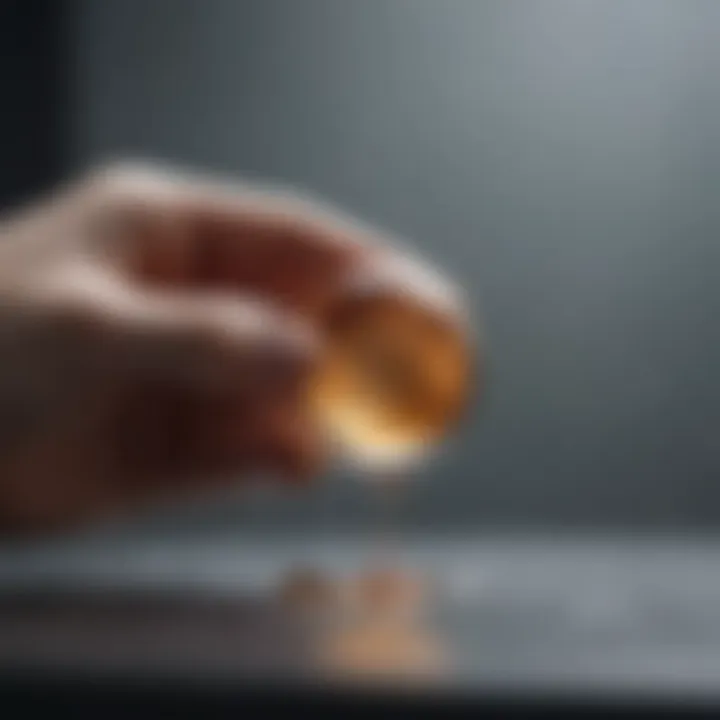Understanding the Clin SOAP Method: A Comprehensive Guide


Intro
The Clin SOAP method is an essential framework in clinical documentation. It shapes how healthcare professionals organize and communicate patient information. This method emphasizes the structured approach to understanding patient health, aiding in clarity and efficiency during clinical assessment.
By dissecting the four main components—Subjective, Objective, Assessment, and Plan—medical practitioners can enhance their decision-making capabilities. This systematic structure not only reveals the patient's status and needs but also streamlines communication amongst the healthcare team.
Through this comprehensive guide, the following discussions will unfold: the significance of each SOAP component, practical applications in everyday clinical practice, challenges faced regarding its adoption, and what future trends suggest for clinical documentation.
Each element of the Clin SOAP framework plays a pivotal role, serving as a roadmap for patient care and improving the overall healthcare delivery system.
Intro to Clin SOAP
In the realm of healthcare, effective communication and precise documentation are paramount. The Clin SOAP method provides a structure that enhances these elements significantly. This framework, which stands for Subjective, Objective, Assessment, and Plan, facilitates a thorough assessment of patient information. It allows healthcare professionals to articulate clinical insights clearly and systematically. A coherent narrative in patient documentation can influence the quality of care delivered and ensure continuity among staff members.
Definition and Background
The Clin SOAP method has evolved over time, drawing from traditional medical documentation practices. The components of SOAP—Subjective, Objective, Assessment, and Plan—are essential for structuring patient visits. The Subjective section captures the patient’s perspective through their reported symptoms and feelings. The Objective component involves measurable data, such as vital signs and physical examination findings. The Assessment synthesizes both subjective and objective data into clinical impressions, while the Plan outlines the proposed care strategy. This format not only enhances clarity but also fosters better decision-making among healthcare practitioners.
Purpose of Clin SOAP
The primary purpose of the Clin SOAP method is to improve communication among healthcare providers. By utilizing a standardized approach, clinicians can ensure that essential information is consistently recorded and easily accessible. This is particularly important in multi-disciplinary teams where various professionals need to collaborate effectively on patient care. Furthermore, the Clin SOAP framework aids in reducing errors that may arise from miscommunication. It encourages comprehensive documentation, which contributes to improved patient outcomes. Overall, the method serves as an integral part of clinical practice, guiding practitioners in making informed decisions based on a structured understanding of patient circumstances.
The Components of Clin SOAP
The Clin SOAP method is structured into four essential components—Subjective, Objective, Assessment, and Plan. Understanding these components is crucial for creating a clear and effective clinical documentation process. Each element plays a significant role in improving patient care, facilitating communication among healthcare professionals, and aiding in accurate diagnoses. This section will explore the individual components in detail, emphasizing their importance and interrelation.
Subjective
The Subjective part of Clin SOAP focuses on the patient’s personal account of symptoms and experiences. This aspect is often the most compelling because it gives voice to the patient’s perspective, which is vital for understanding their condition fully.
Patient's Reported Symptoms
Patient's reported symptoms serve as an invaluable source of information. These are the sensations and experiences that the patient describes, forming the basis for further clinical evaluation. Their key characteristic lies in their direct representation of the patient's experiences, which can highlight both physical and emotional states. This makes it a beneficial choice in understanding how the ailment affects the patient's daily life.
However, there are unique features of this aspect. One major advantage is that it provides context to clinical presentations, allowing for a more comprehensive understanding of the patient’s condition. On the downside, the subjective nature means these reports can be influenced by various factors, including the patient’s perception of their health and communication skills.
Relevance in Diagnosis
Relevance in diagnosis refers to how the patient’s subjective statements can guide healthcare professionals in forming a clinical picture. These statements are not just anecdotes; they carry significant weight in diagnostics. The key characteristic of this aspect is that it bridges the gap between patient feelings and clinical assessments.
This relevance makes it a critical choice for conclusions in case evaluations. A unique feature here is its ability to draw attention to possible conditions that medical tests might not reveal. While recognizing its value, one must also consider that subjective reports can sometimes obscure an accurate diagnosis if misinterpreted.
Objective
The Objective component involves observable, measurable data that healthcare providers gather during examinations. This data is essential for providing a factual basis alongside the subjective accounts from patients.


Clinical Findings
Clinical findings encompass all the detectable signs and measurements taken during examinations. They provide a shape to the information obtained subjectively. The key characteristic is that these findings can be verified and recorded, making them a beneficial choice for supporting clinical decisions.
A unique feature of clinical findings is their reliance on standardized methods, which lends credibility to the documentation. However, a frequent disadvantage is that they might not fully capture the complexity of the patient’s condition if not viewed in conjunction with subjective reports.
Diagnostic Tests
Diagnostic tests involve the procedures and tools used to identify or rule out medical conditions. They serve as critical components in clinical assessment by providing definitive data. The key characteristic here is their capacity to deliver clear, quantifiable results, making them a popular choice in modern healthcare.
These tests often have a unique feature of offering insights that can lead to immediate treatment decisions. However, disadvantages exist as well, such as the potential for false positives or negatives, which can lead to unnecessary anxiety or misdiagnosis.
Assessment
Assessment is the analysis of all collected data—it synthesizes subjective and objective information to formulate a clinical impression. This component is essential for creating a targeted approach to patient care.
Clinical Impressions
Clinical impressions consist of the healthcare provider’s interpretation based on the gathered data. This is a key characteristic of the assessment stage as it incorporates the professional's experience and knowledge. It is a beneficial aspect as it allows for personalized patient care, combining clinical evidence with individual patient history.
The unique feature is the subjective judgment applied to the objective data, which can be both a strength and a weakness, as varying levels of experience among practitioners may lead to different conclusions.
Potential Diagnoses
Potential diagnoses are the various conditions that can be inferred from the patient’s symptoms and the clinician's assessment. The key characteristic of this aspect is its role in directing treatment paths and further investigations. This makes it a crucial choice for managing patient care effectively.
A vital unique feature is the flexibility it offers; clinicians can prioritize multiple conditions based on clinical risk. However, it can lead to confusion if multiple assessments yield conflicting potential diagnoses, underscoring the challenges inherent in clinical reasoning.
Plan
The Plan outlines the strategies for treatment and follow-up for the patient. A well-structured plan is necessary for ensuring effective patient management.
Treatment Strategies
Treatment strategies are the specific actions taken to address identified health issues. This component's key characteristic is its actionable nature, making it a beneficial choice for guiding clinical practices. It lays out tangible methods for resolution, be it through medications, therapies, or lifestyle adjustments.
The unique feature of treatment strategies is their adaptability based on ongoing assessments. They can be tailored to meet the evolving needs of the patient, yet they also carry the risk of being too generic if not customized to individual circumstances.
Follow-Up Care
Follow-up care refers to ongoing monitoring and adjustments of treatment as necessary. This aspect is paramount for the key characteristic of continuity in patient care. It is a crucial choice for ensuring that patients receive sustained support post-treatment.
The unique feature of follow-up care is its potential to catch complications early and reinforce treatment adherence. However, challenges exist, such as missed appointments or communication barriers, that can hinder effective follow-up.
Significance of Clin SOAP in Healthcare


Understanding the significance of the Clin SOAP method is paramount for healthcare professionals. This framework is essential in structuring clinical documentation, which ultimately impacts the quality of patient care. The Clin SOAP format, consisting of Subjective, Objective, Assessment, and Plan, promotes organization and clarity. With a standardized approach, practitioners can ensure that they accurately capture critical patient information, leading to more informative records.
Enhancing Communication
Clin SOAP enhances communication among healthcare providers. It establishes a common language that all professionals can easily understand. When a patient's record is meticulously categorized, it allows smoother transitions of care. For instance, when specialty referral occurs, the receiving physician can quickly grasp the patient's concerns and prior assessments. This not only reduces miscommunication but also minimizes the risk of errors during patient handoffs.
The structured design of Clin SOAP also supports interdisciplinary teamwork. Nurses, physicians, and allied health professionals can refer to the same documentation. This shared understanding fosters collaboration, making it easier to develop coordinated treatment plans that reflect each provider's insights.
Improving Patient Care
The method significantly improves patient care through better data interpretation. By using the Clin SOAP format, clinicians can identify patterns in patients' symptoms more effectively. They can link subjective reports to objective findings, paving the way for accurate assessments and diagnoses. Consequently, clinicians can develop tailored treatment plans that address specific patient needs.
Furthermore, Clin SOAP systematically includes a follow-up plan, ensuring that healthcare providers engage with patients post-treatment. This follow-up is crucial for monitoring progress and adjusting care strategies accordingly. Research suggests that a structured follow-up process often leads to higher patient satisfaction, as patients feel more cared for when their health is consistently monitored.
Clin SOAP is not just a documentation tool; it is a means to foster better healthcare outcomes through effective organization and communication.
Implementing Clin SOAP in Clinical Practice
Implementing the Clin SOAP method in clinical practice is essential for various reasons. First, it establishes a structured approach for documenting patient encounters. This structure helps clinicians capture vital information efficiently. A standardized format also enhances communication among healthcare team members. Moreover, using Clin SOAP can increase the quality of patient care by improving clarity and focus during consultations.
Step-by-Step Guide
To effectively implement Clin SOAP in a clinical environment, follow these steps:
- Training Staff: Ensure that all healthcare professionals understand the Clin SOAP framework. Hold workshops and discussions to train them in documentation practices.
- Integrating into Workflow: Embed the Clin SOAP method into existing documentation systems. This includes electronic health records (EHRs) and other platforms.
- Practice Consistency: Encourage staff to apply the Clin SOAP format in every patient interaction. Consistency is key for effective documentation.
- Feedback Mechanism: Create a system for peer review where clinicians can assess each other’s SOAP notes. This creates a culture of learning and improvement.
- Audit and Review: Regularly audit SOAP notes to ensure compliance and effectiveness. Look for gaps in information or areas for improvement.
Best Practices
When implementing Clin SOAP, adhering to best practices can enhance its effectiveness. Consider the following:
- Keep it Concise: Document only necessary and relevant information. Avoid extraneous details that may distract or confuse.
- Use Clear Language: Avoid jargon and complex terms unless absolutely necessary. Ensure that documentation can be understood by all healthcare professionals.
- Review Regularly: Continuous review of documentation practices keeps the approach fresh and effective. Encourage staff to revisit their notes to assess clarity and completeness.
- Engage Patients: Incorporate the patient’s perspective into the Subjective section. Their reports and feelings are critical to comprehensive care.
- Leverage Technology: Use relevant tech tools, such as templates in EHRs, to streamline and automate the documentation process.
In summary, implementing the Clin SOAP method not only improves documentation but also enriches the entire clinical process, leading to better patient outcomes.
Challenges in Adopting Clin SOAP
The adoption of the Clin SOAP framework in clinical settings has numerous advantages, yet it is not without its challenges. Understanding these obstacles can significantly impact the successful integration of this method in healthcare environments. Recognition of these challenges can help tailor interventions that enhance adoption rates and improve overall patient care. It is essential to consider specific factors that impede the use of Clin SOAP and to explore solutions that can facilitate smoother transitions into this documentation style.
Common Barriers
Several common barriers exist that prevent healthcare professionals from fully adopting the Clin SOAP method. Some of the more notable factors include:
- Resistance to Change: Many practitioners are accustomed to their existing documentation methods. Change often requires a mindset shift, which can be slow and met with reluctance.
- Lack of Training: Insufficient training on how to implement Clin SOAP effectively can lead to confusion. Professionals may feel ill-equipped to adopt this method if they do not understand its structure and purpose.
- Time Constraints: The fast-paced nature of clinical work can hinder the ability to consistently apply the Clin SOAP framework. Practitioners may prioritize immediate patient care over documentation methods.
- Inadequate Support Systems: Institutions may not provide the technological or administrative support necessary for implementing Clin SOAP, which can lead to frustration and inconsistency in practice.
"The full integration of any documentation method is fundamentally tied to the system's readiness and the personnel’s willingness to adapt."


Solutions to Overcome Challenges
Addressing these barriers requires a multifaceted approach to ensure successful adoption of Clin SOAP in healthcare settings. Solutions can include:
- Comprehensive Training Programs: Implement targeted training sessions to educate staff on Clin SOAP. Training should cover not only the mechanics of the method but also its potential benefits in improving communication and patient outcomes.
- Creating Support Structures: Establish a system of support where experienced personnel can mentor less experienced team members. This bolsters confidence and encourages the practice of the Clin SOAP method.
- Time Management Strategies: Encourage staff to allocate specific time for documentation. Integrating documentation into daily routines can help alleviate the pressure felt by practitioners.
- Advancements in Technology: Leverage electronic health records (EHR) systems that facilitate the Clin SOAP format. EHRs can streamline the documentation process, making it less time-consuming and more efficient.
Future Trends in Clinical Documentation
The landscape of clinical documentation is rapidly changing. As healthcare evolves, the need for comprehensive and efficient documentation is more critical than ever. Future trends in clinical documentation will increasingly shape how healthcare providers interact with and manage patient information. Understanding these trends is essential for students, researchers, educators, and professionals in the field. The integration of technology, increasing regulatory standards, and a focus on patient-centered care are among the key elements driving the future of clinical documentation.
Technological Advances
Technology is transforming the way clinical documentation is approached. Electronic Health Records (EHR) systems are at the forefront of this change. These systems streamline data entry and improve accessibility, enabling healthcare providers to retrieve patient information quickly. The benefits of EHRs are numerous:
- Efficiency: They reduce the time spent on paperwork, allowing clinicians to focus on patient care.
- Interoperability: Enhanced data sharing between different healthcare providers facilitates coordinated care.
- Data Analytics: Advanced analytical tools can process large amounts of data, aiding in clinical decision-making.
Moreover, artificial intelligence (AI) is playing a significant role in automating documentation processes. AI solutions can analyze clinical notes, extract relevant data, and even suggest treatment plans based on patient history. This means that healthcare professionals will spend less time on documentation and more time on patient interaction.
Evolving Documentation Standards
As technology advances, so do the standards for clinical documentation. Regulatory bodies are continuously updating guidelines to enhance compliance and improve patient safety. These evolving standards often focus on:
- Quality of Documentation: There is a growing emphasis on producing high-quality, precise documentation that accurately reflects a patient's health status.
- Standardization: Making the documentation process uniform across various healthcare settings ensures consistency and reduces errors.
- Patient Involvement: Increasingly, patients are expected to participate in their documentation. Patient-generated health data is becoming more valued, with the aim of providing a holistic view of their health journey.
Adherence to these standards is crucial for successful healthcare delivery. Organizations must remain informed of changes in regulations and invest in staff training to ensure compliance.
"Documenting patient care thoroughly is not only a legal requirement but also a moral obligation to ensure quality care."
Finale
In this section, we underscore the vital role of the Clin SOAP method in modern clinical documentation. This framework organizes patient information effectively, fostering clarity in communication among healthcare professionals. The proactive approach of using Clin SOAP can lead to improved patient outcomes, making it an essential tool in medical settings.
Clear documentation supports continuity of care. When healthcare providers utilize the Clin SOAP format, they ensure that important details about a patient's condition are readily accessible. This accessibility can aid in future assessments and treatments, establishing a more comprehensive understanding of the patient's medical history.
Furthermore, clinician training in this method enhances overall practice efficiency. By following a structured format, providers develop a routine in documentation, which can help to reduce errors and omissions in patient records.
"The Clin SOAP method offers a systematic approach to clinical documentation that can transform patient care."
Effective implementation of this method also encourages interdisciplinary collaboration. Different medical specialists can align their understanding of a patient’s case through standardized notes, ultimately serving the patient's best interests.
Summary of Key Points
- The Clin SOAP method is a framework for organizing patient information.
- It enhances communication and consistency in clinical documentation.
- This approach contributes to patient-centric care and improvements in outcomes.
- Training in Clin SOAP fosters better practices and reduces errors.
- It facilitates collaboration between various healthcare professionals.
The Importance of Clin SOAP in Modern Medicine
The significance of the Clin SOAP method in contemporary healthcare cannot be overstated. As healthcare systems embrace digital documentation, the need for standardized methods becomes increasingly critical. Clin SOAP provides that standardization.
It allows for ease in information transfer between various platforms and professionals. In a world where patient data is commonly shared electronically, the Clin SOAP format ensures that key aspects of a patient’s care are not lost in translation.
Moreover, the increasing complexity of patient cases in modern medicine demands a reliable method of documentation. Each component of Clin SOAP—Subjective, Objective, Assessment, and Plan—plays a crucial role in capturing a holistic view of a patient's health status.
In essence, Clin SOAP is not merely a method of documentation but a vital strategy for raising the quality of patient care in a rapidly evolving healthcare landscape.







